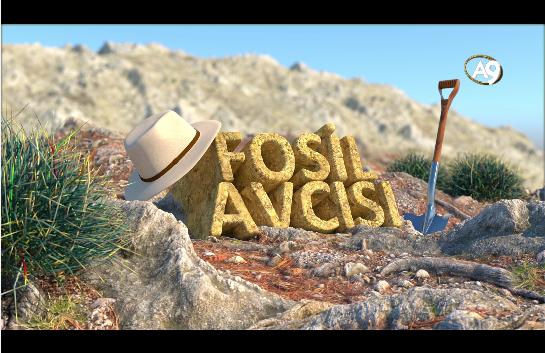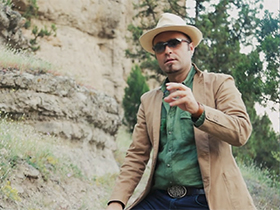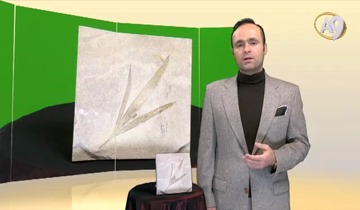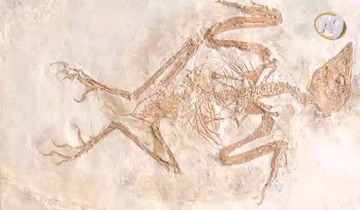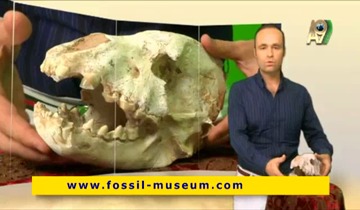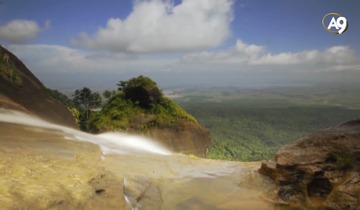Welcome to the Fossil Hunter. Fossils are the most important evidence proving the existence of God. There are so many fossils on the planet. Here, we will show you some of the biggest and most famous fossils in Turkey. The Fossil Hunter starts now!
Istanbul – one of the most beautiful cities in the world. Today, the city will host an important event: The “2nd International Conference on the Origin of Life and the Universe.”
2nd International Conference on the Origin of Life and the Universe
Local and foreign speakers participated in the conference that was initiated by Mr. Adnan Oktar and organized by the Technics & Science Research Foundation. The event was crucial in the sense that the errors of the theory of evolution were presented in a scientific level. We are now proceeding towards the fossil exhibition which is held right next to the conference hall. The exhibition, which was prepared with great efforts, is full of unique items.
This is a beautiful fossil exhibition right here. It is a wonderful exhibition. I am here with Erdem and Cihat. Cihat, let’s stand here so our viewers can see the fossils better. What do we have here? A sea turtle; this is a very special and beautiful fossil.
Sea Turtle
Age: 65 Million Years
When you take a closer look at it, you can see that it was excavated with great efforts. It is very fragile but the paleontologists are working really hard, and they put great effort into excavating such detailed fossils. But once they finish excavating, they provide us with such wonderful pieces of evidence of creation by God. How old is it? 65 million years old. This is one of the very special fossils which makes it clear that it was exactly the same 65 million years ago.
From the Eocene epoch.
Yes, it is from around that time.
The fact that it has not changed at all for 65 million years clearly proves that an evolutionary process does not exist.
Well, in living creatures, as you know Cihat is a doctor of medicine, phenotype, I mean the appearance, is directly associated with genotype, namely, the DNA. This creature’s genes are exactly the same with the genes it had 65 million years ago; there is no difference between them. Nothing is different. You know, evolutionists always hope for something wonderful to come into existence through mutations. They always speculate that there are new genes. However, what this fossil shows us is that neither the genotype, or genetics if you will, nor the appearance has ever changed.
These are solid evidences that cannot be denied.
Solid evidence.
Rock-solid evidence, since it is a rock.
Researcher Erdem Ertüzün
What we have here is a fossil turtle. There are many fossil turtles around here. But if you compare these fossils to turtles living all around the world today, you will see no difference. Both are exactly the same. But the theory of evolution claims that mutations are what gave this turtle these legs, this head, and this tail. They claim that mutations gave the turtle all these things in a random fashion. According to that claim, we should be seeing many disfigured, asymmetrical, pathological versions of this fossil, like one with a leg coming out of its back, one with a tail on its neck, or one with a head coming out of its back; however, there are no such creatures. You don’t see such turtles out there. They are all like this fossil.
Sea Turtle
Masha’Allah.
Masha’Allah.
Masha’Allah.
Thank you very much, my friends.
We asked Dr. AJ Roberts, a doctor on molecular biology, why the mutations in question could not have generated a new gene.
AJ Roberts
Oh, that's a great question. Mutations are thought of as the basic mechanism for generating novelty in the evolutionary story, right? But when we start to talk about evolutionary novelty I think this is one of the biggest hurdles that evolution theory faces because novelty doesn't mean that I'm just duplicating something that's already there or rearranging something that's already there, scrambling and hoping that once I scrambled it or rearranged it that I've produced a novel information. We can also get genes passed in from other organisms that might introduce novelty but when we realize they were already in another organism then it's not really, truly novelty that’s being driven through these basic evolutionary mechanisms like mutations. So, I think evolutionary novelty is a very high hurdle for naturalistic explanations and I think that's one of those things that points us strongly to design because information is difficult to generate this way.
We have a jellyfish here. It is a creature that has soft tissue but it is a creature whose fossil reached us in the present day from 425 million years ago. The jellyfish is a creature that negates the evolutionist claim that there once was a primal creature which eventually turned into something complex. Even the name refers to “true tissue,” animals with true tissue. Jellyfish is classified in the subkingdom of animals with true tissue. This fossil is 425 million years old; it is one of the oldest specimens of a jellyfish. Theorists of evolution imply that jellyfish is the first complex creature with such tissue, that there were no preceding creatures with tissue, organs or a biological system other than the cell. But that’s not true. The truth is that complex creatures with tissues, organs and systems suddenly came into existence in the Cambrian period. Now, let’s take a closer look at this jellyfish. I am opening up its lid.
Jellyfish
Age: 425 Million years
As we clear these parts off of its top, we start to see the rock itself. As we are taking a closer look at it, we see the state of a 425-million-year-old jellyfish that came to us along with this remain. The circular jellyfish only left a stain right here. Its tissue is almost completely gone, though there is a small bump on the top. The rest of it left a stain here as a rock. Its details are clear. In fact, let me slowly show you its edge. This is a rock. So we think that the fossil was formed between two separate layers of the rock. Well, if you consider the layered structure of the rock, it is possible to split the two layers and excavate the fossil. Let’s consider this as a rock layer. There are some fossils left on it. Well, think about how when creatures die today, they sink into the bottom of the ocean. Then, the sludge piling up on it creates a new layer. Formation of a new fossil starts right there. This right here is a jellyfish that lived in Morocco 425 million years ago.
Prior to the conference, I had a little chat on fossils with our dear friend, biochemist Dr. Fazale Rana. He lives in the United States. We talked about the Cambrian fossils that were found both in the state of Wyoming and right above the States, in British Columbia, Canada. My question was: What can we surmise from fossils found in Wyoming, USA, and other places? Second: What do these fossils tell us?
Dr. Fazale Rana- Biochemist
Dr. Fazale Rana
Well, one of the things that I think really interesting is that when we discover fossils, many times the organisms that we discover look like the modern forms. The technical term for it is "stasis." They don't seem to have undergone any kind of change and some of these fossils are hundreds of millions of years old. The fact that we see so many examples of stasis raises some questions in my mind: is there really an evolutionary history of life that we can derive from the fossil record or does it more look like the work of a Creator?
Onur: What is the importance of the Cambrian fossils, Mr. Fazale?
Fazale Rana: The Cambrian fossils are the first instance that we see in the fossil record of complex animals, and what is astounding is that those fossils show up instantaneously in a geological layer. There is nothing preceding them that indicates any kind of evolution; they just show up explosively in the history of life. This is called the Cambrian explosion and there are, you know, every phylum that we know of has a counterpart in the Cambrian explosion. It is an event that defies evolutionary explanations. Meanwhile it is one of the most important events in the history of life, when complex animals first appear. To me that looks like a signature of a Creator's handiwork.
At the conference venue, fossils were exhibited with all their magnificence. You can see a 20-million-year-old fossil rhino here.
20-million-year-old fossil rhino
This is a fossil skull – a fossil that reached us today from 20 million years ago. Its lower teeth are still intact but its long horn did not make it. As you can see, it is no different from rhinos living today. We can show this fossil together with that rhino over there. So, this is a rhino from today’s world, and this is a 20-million-year-old one.
After having a delicious meal, let’s continue our tour of the exhibition.
Here, we have a huge, very special fossil – an alligator. Let’s take a closer look. I believe this is a baby alligator at its full length. It’s 1 to 1.5 meters long. Again, this is an alligator that lived in China 65 million years ago. We have removed the plastic protector wrapped around the fossil. You can see its tissue clearly right here.
Alligator
Age: 65 Million Years
This is an Asian alligator. It’s the fossil of an alligator that lived in Asia 65 million years ago. You probably know about the surface of swamps – a dark and thick layer. Imagine how that surface petrifies after a creature living in there dies. This is how the surface looks now when the water vaporizes. It’s dark-colored. It shows every detail of the fossil within.
As you know, an alligator’s outer skin is very tough and firm. They have something like a natural fiberglass in their skin, so their skin has a perforated surface. Well, their skin is not smooth, it is perforated. Here is its mouth, its jaw, its skull, its teeth, its feet coming out of its body – it has 4 legs and its tail reaches over there. There is no difference between this fossil and an alligator living today. This is a beautiful fossil.
It is one of the giant fossils clearly showing us that there is no difference between the alligators that God created 65 million years ago and that of today’s world. Masha’Allah. It is dark and relatively softer. This is not a very solid rock; it is a little soft, which is why it has a fragile structure. These are handled carefully and exhibited here.
In this exhibition one of the interesting samples of fossilization is this one. This is a fossil snake. I’m opening it now. Let me grab it. Okay, so, this is a snake. This is the fossil of a snake that lived in Germany 50 million years ago. I’m putting its description card back.
Snake
Age: 50 Million Years
In terms of its structure, when you examine it carefully, snakes today have the same body features as they had 50 million years ago. It is no different from snakes living today.
Now, what is interesting here is that this is not a rock layer: This is a substance like a soft fiberglass or a type of wax. It is like plastic. Well, you may ask, “So how did this fossil form?” When you look at it in this direction, it is transparent. I don’t know if you can view it clearly through the camera lens, but it has a transparent structure.
I can see the light behind it. I can show you this under some light as well. Now, they locate this fossil and excavate it. They dig, and once they successfully excavate it, they place it inside a plastic container. Then, they let it dry out. So, what I am holding right now is in fact a protective case for the fossil. The fossil itself, as you can see, is as solid as a rock. The surface, in fact, is rock. But the other parts are for fossil’s protection since it is very fragile. They have been put on to the fossil to preserve it.
Lastly, I asked Mr. Jeff Gardner, an American journalist, about why evolutionists defend their theories so insistently even though there is strong scientific evidence against evolution.
Those who put the theories forward hold on to that system, even in the face of evidence that's contrary to that. And this happens all the time within science. Science is not a wholly unbiased, objective process. It is just not how it works. If a scientist were to say that, they have been fundamentally dishonest. So we are going to start by saying that we are honest with the facts, start by being honest about how the scientific process and the scientific community operates, which is fair.
Jeff Gardner - Director of the Picture Christians Project
As the day turns to evening in Istanbul, our conference still continues in full course. May God bless all of our brothers and sisters who contributed to this beautiful conference. It has been a wonderful and very effective event. May God let us organize better and more effective conferences in the future as well. We will meet in a new episode, God willing. Goodbye!
We’d like to thank everyone for their attendance at the conference. Our dear guests, thank you very much as well.



